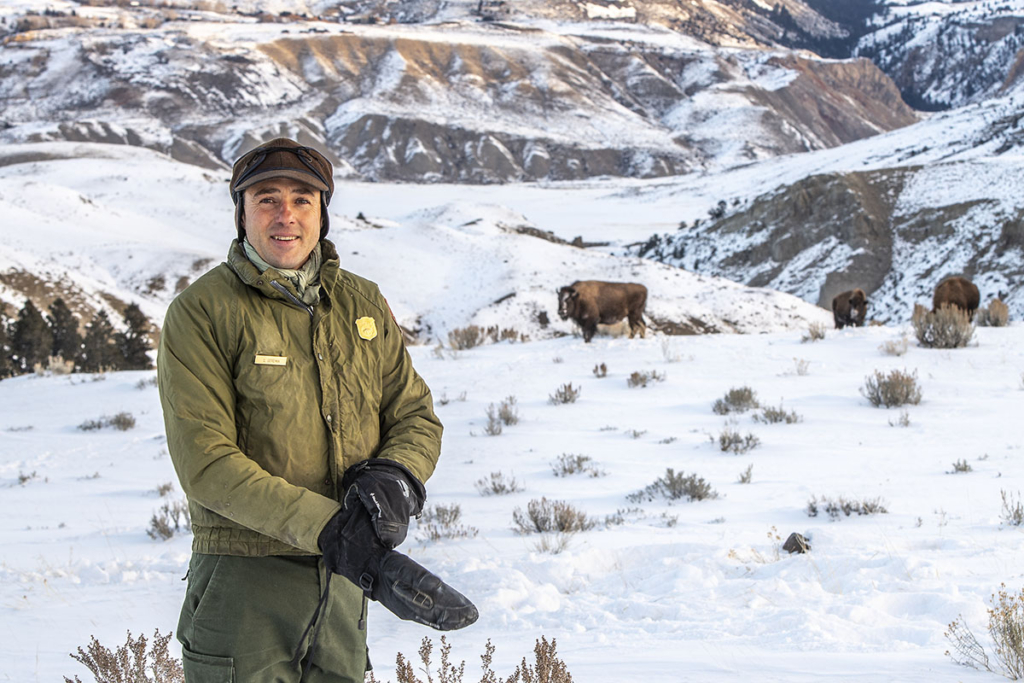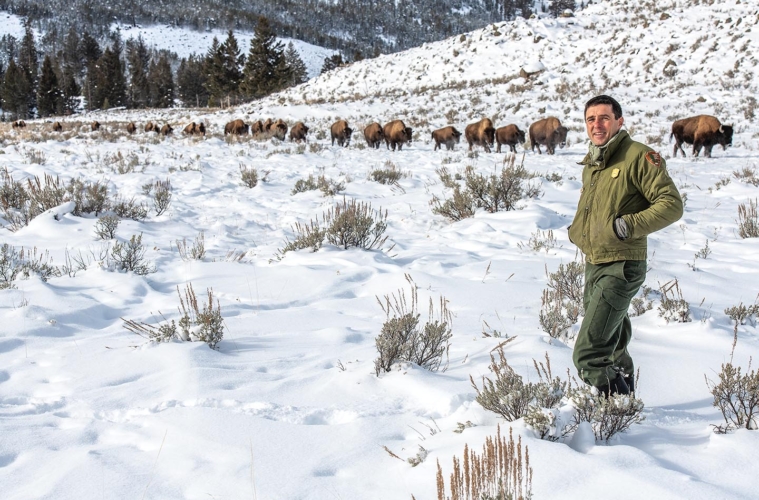Chris Geremia ’99 manages the largest bison herd on earth.
Yellowstone National Park has experts for wolves, cougars, and fish. Chris Geremia ’99 is the bison guy. As the park’s senior bison biologist, he manages the largest bison herd on earth. There are now 6,000 bison in the park. He wants to lift the number to 10,000.
“I’ve always been drawn to open places and wild things,” he says.
When Europeans arrived in America, there were tens of millions of bison roaming the continent. By the 1880s, they faced extinction because the Army was killing them to starve Native Americans in the Great Plains. Deciding some bison should be saved, Congress in 1884 made it illegal to kill them in national parks. There were a couple hundred living in Yellowstone. The park supplemented its herd with animals bought from ranchers. It put them in pens and raised them like livestock.
By the time Geremia arrived in 2002, bison were roaming freely in the park and were at the center of what he calls “a biological, cultural, and societal war.” On one side were conservationists who wanted more bison. On the other were ranchers who wanted to eliminate bison because they carry brucellosis, a disease that can spread to cattle. When bison slip out of the park and infect the cattle, it causes cows to abort their offspring. Geremia has spent much of the last 20 years monitoring, implementing, and negotiating deals between the two warring factions. “The issue is just incredibly interesting to me,” he says.
Geremia grew up in Smithtown on Long Island. When he got to Colgate, Josh and Molly Ames ’91 Baker, who now run an outdoor apparel store in Michigan, were directing the University’s Outdoor Education Program. They needed instructors to teach rock climbing and skiing. Geremia stepped up and also agreed to lead hikes for first-years in the Adirondacks, where he got a deeper understanding of life outdoors. After graduating with a math degree, he took an unpaid internship at the Grand Canyon, where he worked on native plant conservation. He did search and rescue missions part time, saving hikers who couldn’t make it up from the gorge. After ranger academy, he went to Yellowstone. Because he could ski, he was assigned to the winter bison count. “The skills I learned at Colgate somehow made me the person to ski around the back country of Yellowstone to track bison,” he says. Along the way, he earned a PhD in ecology.

Bison weigh as much as 2,000 pounds, making them the biggest animals in the country. They’re surprising agile. When provoked, they can spin around to confront an attacker. Geremia’s work takes him into the middle of herds. Bison are more curious than menacing. But if they think they’re being challenged, they’ll snort, raise their tails, scrape their hooves, and, once in a while, charge. He has been attacked a few times, like when he was on a horse and tried to shoo a large bull out of the way by riding into it. “I’ve made some poor decisions,” he says. “If a big bull starts posturing at you, walk away. That will diffuse the conflict.”
Bison are prolific breeders and, if left on their own, they would overrun the park. To keep numbers in check, some are destroyed every year or allowed to wander outside the park where they are fair game for hunters. Geremia wants to minimize the killing. That’s where the Bison Conservation and Transfer Program comes in. In recent years, Yellowstone, with financial help from the nonprofit Yellowstone Forever, has been resettling bison on Native American reservations.
On a chilly night last October, Geremia was working the floor at Yellowstone’s Canyon Lodge, shaking hands with supporters of Yellowstone Forever. Other biologists at the lodge that night had mountain beards. Geremia stood out. With his khakis, a blue sweater, and Yankees cap, he looked preppy. A clean-shaven baby face completed the picture. “I’m 46, but people say I look 26,” he says.
Asked to name a favorite part of his job, he cites watching bison leap out of trailers when they’re moved to reservations and spared from slaughter. “It’s one of those moments,” he says. “It feels like such a success.”
— Greg Steinmetz ’83, P’23,’26 is the author of American Rascal: How Jay Gould Built Wall Street’s Biggest Fortune (Simon & Schuster, 2022). His wife, Arikha Moses, belongs to the National Advisory Council of Yellowstone Forever.

